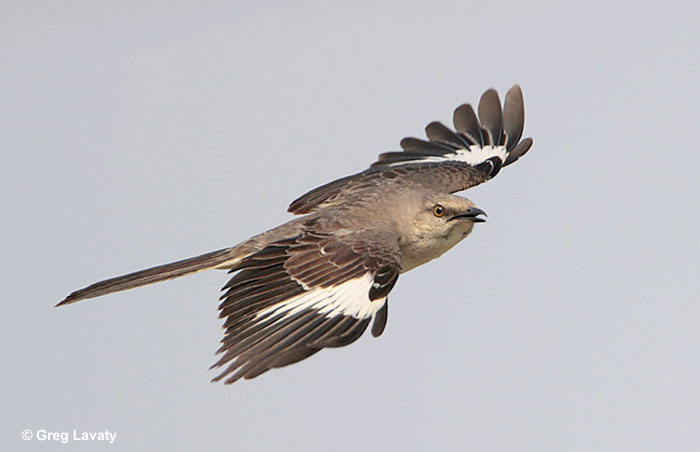
The state bird of Arkansas is the Northern Mockingbird. This fairly large, long-tailed, gray bird with white underparts, two white wing bars and a small white patch in the wing lends a cheerful touch to neighborhoods across the state. It is a conspicuous and familiar species that loves to feed on lawns and constantly sing from bushes, trees, and rooftops.
Arkansas is mid-sized state in the southern-central part of the country. It became a state in 1836, and is named after the Arkansas River, a tributary of the Mississippi River that flows from the western part of the state to the southeastern part of Arkansas.
The capital city, Little Rock, is located in the center of the state and somewhat marks a boundary between more mountainous areas in the northern and western regions, and low-lying regions in the southeast. Arkansas has an area of 53,179 square miles and a population of a bit more than three million.
History
The Northern Mockingbird (scientific name Mimus polyglottos roughly translates to many-languaged mimicker) became the official state bird of Arkansas on March 5, 1929, as a direct result of lobbying by the Arkansas Federation of Women’s Clubs (AFWC), a group that had also worked to help protect various other bird species in the state.
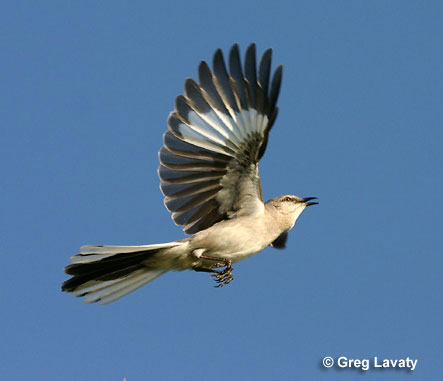
Even before they lobbied to name it the Arkansas state bird, the Northern Mockingbird was already a popular, well-known and cherished bird species in Arkansas. This bird is very common in most parts of the state, especially in backyards and parks, and it fills the air with cheerful, melodious songs at all times of the day.
The species also received a boost in public support in 1903, after ornithologist William Dutcher showed that farmers benefited from mockingbirds because they helped protect crops by feeding on the seeds of weeds, and on insects.
The final push to give the Northern Mockingbird official state bird status happened after the state prosecuted and fined a man for keeping one in a cage. The AFWC used this news item and subsequent publicity to successfully encourage the Arkansas legislature to name the Northern Mockingbird the official state bird of Arkansas.
This popular bird species is also the state bird of Texas, Florida, Mississippi, and Tennessee.
Facts about The Northern Mockingbird
- The Northern Mockingbird is an incredible mimic, and its songs often include various bits of vocalizations of other bird species. Its repertoire has included vocalizations from more than 200 other bird species as well as car alarms and other random sounds.
- On account of its impressive singing abilities, during the 19th century, the Northern Mockingbird was a popular and highly valued cagebird. Some prized singers were bought for large sums of money! This resulted in greatly reduced populations of mockingbirds in urban areas until it became protected by the Migratory Bird Treaty Act in 1918. Some prized singers were bought for large sums of money!
- In Harper Lee’s novel To Kill a Mockingbird, mockingbirds are seen as symbols of innocence.
- When foraging on the ground, the Northern Mockingbird often shows the white spots in its wings by quickly opening and closing them. This could help flush insects out of hiding and/or be related to territorial displays and attempts to scare off predators.
- Northern Mockingbirds are very defensive of their nests and won’t hesitate to dive and swoop at anything that comes too close, people included.
- Several Mockingbird species live south of the United States but the Northern Mockingbird is the only species resident in the USA and Canada, and the most accomplished mimic.
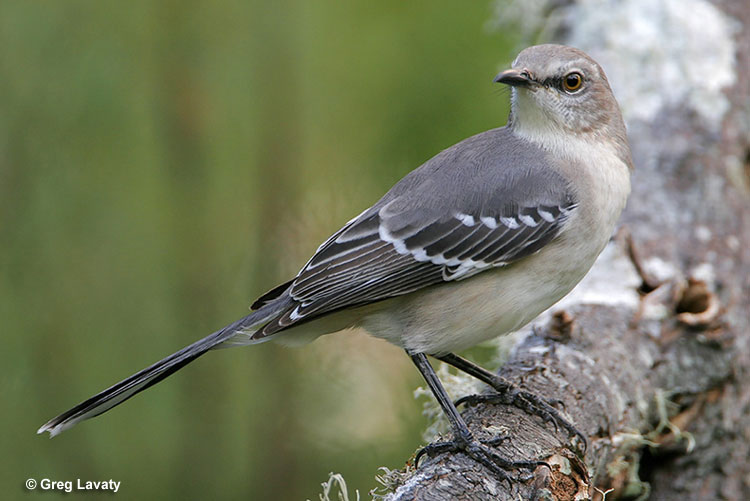
Identification
The Northern Mockingbird is a fairly large and slender, Robin-sized bird with a gray coat, whitish undersides, long tail and some white patches on their wings.
This elegant bird has straw-colored or yellow eyes with narrow white crescents above and below them, and a bit of black or dark gray between the eyes and the bill. It also has two white wing bars, a prominent patch of white in the wing, and tan highlights on the flanks.
Males and females look alike, but males tend to be larger, weighing 1.7 ounces on average, whereas females have an average weight of 1.6 ounces. Their wingspan is around 13 inches. On account of variations in size, some female mockingbirds are larger than males.
The Northern Mockingbird usually flies brief distances between bushes and other vegetation, but some can also make short migrations. But in general, they tend to be a permanent resident in their preferred habitat. When it does fly, it shows rounded wings with a prominent white patch.
The juvenile Northern Mockingbird looks like the adult but has a “messier” appearance, faint spotting on the underparts, can have more or less white in the wings than adults, and has more extensive pale coloration on the base of the bill.
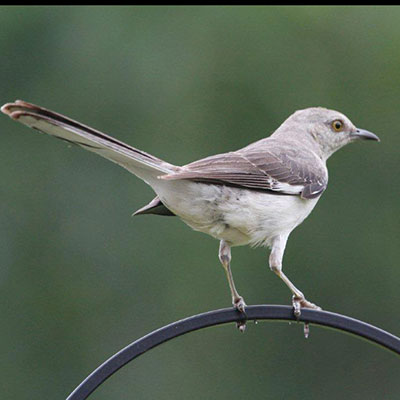
Call
The song of the Northern Mockingbird is one of the most commonly heard and distinctive bird songs of the southern United States. This species gives several brief phrases of varied warbling notes and mimicry of other bird species over and over.
It often repeats each warbling sound, and mimicked calls, three to four times before pausing for a couple seconds and then singing repetitions of other musical phrases. The sounds of cell phones and mechanical noises can also be included in its songs, and it can mimic a huge variety of species.
In much of its range, some of the most frequently heard bird species include the Blue Jay, Carolina Wren, and Tufted Titmouse.
This species also gives a harsh “check” call, often while foraging or in flight. No species in North America sounds quite like the Northern Mockingbird as none have such an impressive repertoire of vocalizations.
The related Gray Catbird sings a complex, jumbling variety of notes, and several thrasher species can have somewhat similar songs but none have songs that include a variety of mimicked sounds and warbling, “treedle”-like phrases.
Behavior
The Northern Mockingbird is a bold and curious bird species often seen in the open. It avoids forest, and prefers open areas with scattered trees and bushes, dense growth at the edge of forest, and second growth.
Northern Mockingbirds can sing all day and night from a tree, rooftop, or top of a bush. When not singing, this bird species often forages for insects (such as beetles, spiders, grasshoppers, ants, and other bugs) by hopping and picking them off the ground in open situations. They eat winter berries and fruit when it’s cold outside.
It also visits bushes and trees to feed on berries, nests in gardens, parks, and near people, and has increased on account of using a commonly planted invasive, the Multiflora Rose.
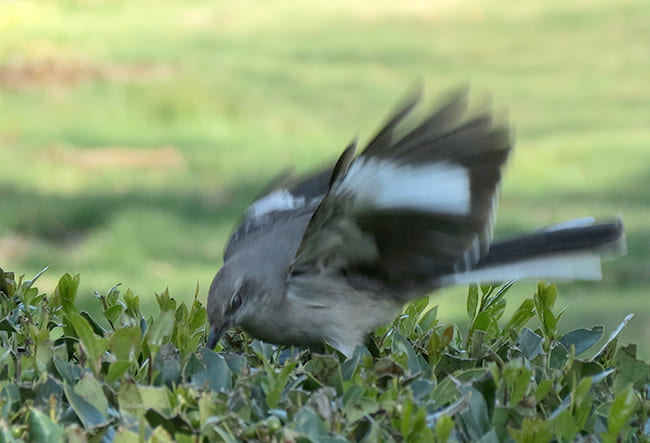
The Northern Mockingbird is often very aggressive towards other bird species, especially when feeding on berries, and quickly chases other birds away to protect its food source.
During the breeding season, they are especially aggressive around their nest and territory and frequently dive and swoop at any intruding birds, dogs, cats, or people. Northern Mockingbirds make their nests out of twigs, rootlets, leaves, and grass.
Interestingly, female mockingbirds sometimes start making a second nest while the male is still caring for their young birds.
You Might Also Ask
What is the state bird of Arkansas?
The state bird of Arkansas is the Northern Mockingbird.
Why is the Northern Mockingbird the state bird of Arkansas?
The Northern Mockingbird is the state bird of Arkansas because it is a common and well-known bird in the state. Known for its beautiful songs and ability to mimic other bird species, the Northern Mockingbird represents the rich avian diversity and natural heritage of Arkansas.
When did Arkansas choose its state bird?
Arkansas designated the Northern Mockingbird as its state bird in 1929.
What other states have the Northern Mockingbird as their state bird?
In addition to Arkansas, the Northern Mockingbird is also the state bird of Florida, Mississippi, Tennessee, and Texas.
Next up in Arkansas: Most common birds | Woodpeckers

